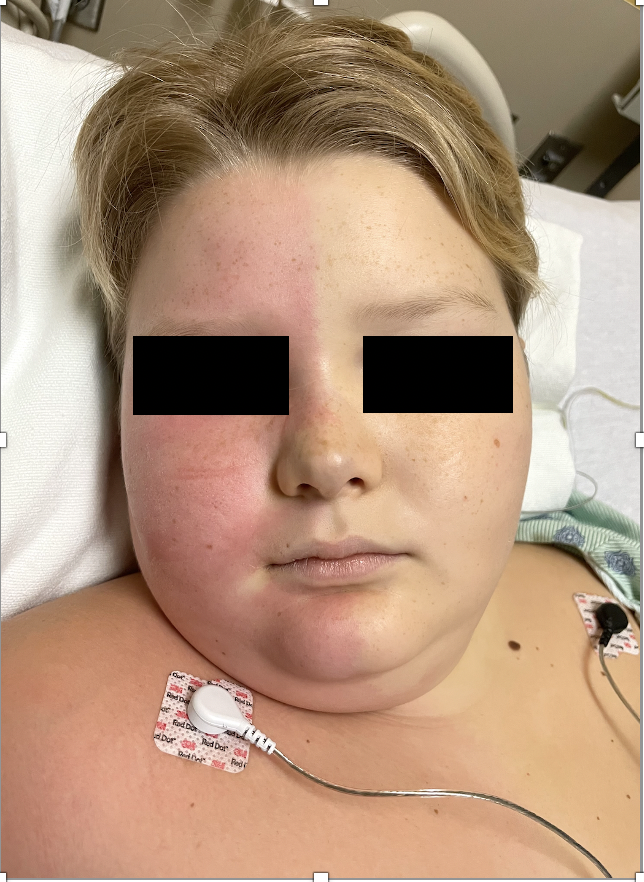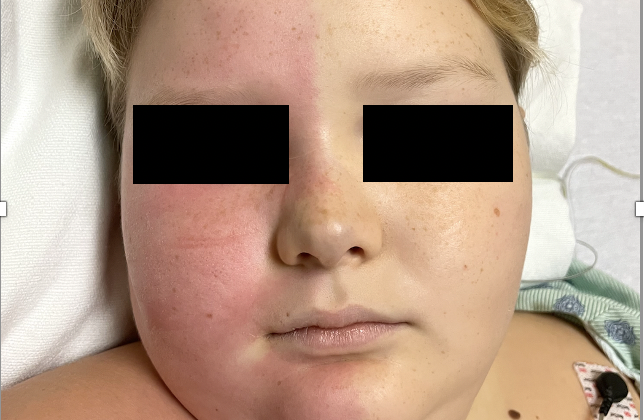What is Harlequin Syndrome?
Harlequin syndrome is a rare condition that was first recognized by Lance and others in 1988. People with this condition experience changes in facial coloration, showing a clear line down the middle of their face. This happens because something interferes with the nerves on one side of the face, nerves that control blood vessels and sweating. The exact cause is often unknown, but it can be triggered by things like exercise, strong emotions, spicy food, or heat.
Furthermore, Harlequin syndrome might be a sign of health problems affecting the neck and upper chest. Sometimes, the nerves that control blood vessels and sweating might be squeezed or damaged during surgery or anesthetic procedures around the neck.
Generally, Harlequin syndrome is not dangerous and usually clears up on its own. But, its sudden and noticeable symptoms can be quite distressing and anxiety-inducing for the patient and their loved ones. Therefore, it’s important for healthcare professionals to be familiar with this condition so they can identify it and provide appropriate care to the patient.
What Causes Harlequin Syndrome?
Harlequin syndrome is a condition that affects the nerves on one side of the face, causing symptoms such as sweating or flushing. For more than half of the cases, we don’t know exactly why it happens, which is called idiopathic Harlequin syndrome. It doesn’t seem to be linked to our genes.
Various things might lead to Harlequin syndrome, including lack of maturity, injury, pressure, or blockage of the nerve fibers that supply the face. It’s a common condition in newborn babies, likely because the part of their brain that controls bodily functions (the hypothalamus) hasn’t fully developed, and their blood vessels aren’t always stable. Being put to sleep with general anesthetics or receiving prostaglandin infusion (a medical treatment), both of which affect blood vessels, might bring out the symptoms more clearly.
In adults, exercise can cause blockage of a blood vessel (the third thoracic radicular artery), leading to Harlequin syndrome. So can abnormalities of nerve cells in the spine’ migration (neural crest cells), small blood vessel blockages caused by infections such as the human herpes simplex virus-6, cytomegalovirus, parvovirus, chickenpox, or autoimmune conditions (where the body’s immune system mistakenly attacks its own tissues) that affect the nerves, like Guillain Barre syndrome, multiple sclerosis, an overactive thyroid (hyperthyroidism), or diabetes-related nerve damage.
Some of the cases are iatrogenic, meaning they’re unintentionally caused by a medical treatment or procedure. This might occur after surgery or receiving anesthetics. When Harlequin syndrome happens after being anesthetized, it’s usually because the anesthetics accidentally blocked the nerves’ supply to the face while giving regional or spinal anesthesia (a type of anaesthesia that numbs a large part of the body). It can also happen after accidental injury from a needle, such as when a tube is inserted into the vein in the neck for heart bypass surgery (VA ECMO neck cannulation) or central venous catheterization.
During neck surgeries, if the nerves supplying the face are unintentionally pinched or cut, it might result in Harlequin syndrome.
Harelquin syndrome can occur due to many causes (listed below), but are broadly broken down into three main categories:
1) Harlequin syndrome that happens for no apparent reason (idiopathic Harlequin syndrome)
2) Harlequin syndrome that happens because of an underlying issue (secondary Harlequin sign), which can be due to:
– Structural issues like tumor in the upper part of the lung (Pancoast tumors), tumors affecting the nerve supply to the face (cervical sympathetic tumors), tear in the neck carotid artery (cervical carotid artery dissection), birth injuries, fluid-filled cavity within the spinal cord in the chest region (thoracic syrinx), tissue death in the lower part of the brain (medullary infraction), or bleeding in a part of the brain (thalamic hemorrhage)
– after anaesthetic procedures like thoracic epidural, paravertebral blocks, multilevel intercostal nerve block, interscalene block, erector spinae plane block and jugular venous lines
– After surgery like carotid endarterectomy, thyroidectomy, anterior cervical discectomy, neck schwannoma excision, rotational spine surgeries, VA ECMO, thoracic sympathectomy or removal of a mass in the neck or mediastinum (part of the chest between the lungs).
3) Harlequin syndrome affecting newborn babies (Harlequin syndrome of neonates).
Risk Factors and Frequency for Harlequin Syndrome
Harlequin syndrome is often seen in women and is also not rare among healthy newborns, with around 10% of them experiencing it. This syndrome generally appears between the 2nd and 5th day after birth and is unlikely to occur after three weeks. Even though it was previously thought to occur more in premature babies, recent data shows it is just as common in full-term healthy babies.

the midline from the contralateral pallor
Signs and Symptoms of Harlequin Syndrome
Harlequin syndrome is a condition that usually begins suddenly and can be triggered by strong emotions, hot temperatures, or physical activity. The symptom includes one side of the face becoming pale, dry, and cool, while the other side may appear flushed, reddened, and sweaty. These changes are usually noticeable along the middle line of the face, resembling the appearance of the character ‘Harlequin’ from Italian theatre.
The duration of these facial changes can vary. They could last from a few seconds to minutes, and sometimes even hours, before the face returns to normal. The frequency of these color change episodes can happen inconsistently over time, depending on the triggering factors mentioned.
The scope of this distinct demarcation can sometimes extend to the arms and the chest, depending on the extent of the affected nerve fibers. Particularly in newborn babies, who have an underdeveloped hypothalamus (a part of the brain), the discoloration can affect the entire half of the body.
In addition, people with Harlequin syndrome may experience associated symptoms, such as cluster headaches, forehead sweating, and runny nose. Other symptoms might include tearful eyes, a constricted pupil, or drooping of the upper eyelid. On the other hand, they do not experience any sense-related or movement-related problems. In some cases, the only symptom may be a difference in facial temperature without any changes in skin color – this is sometimes referred to as “subclinical Harlequin syndrome.”
- One side of the face becomes pale, dry, and cool to the touch
- The other side appears flushed, reddened, and sweaty
- The changes might last from seconds to minutes, even hours
- The discoloration can sometimes extend to arms and chest
- Associated symptoms could include headaches, sweating, and runny nose
- There can also be tearful eyes, a constricted pupil, or a drooping eyelid
Occasionally, Harlequin syndrome can occur alongside another medical condition. In such cases, the facial discoloration might last longer and could become a permanent feature. This discoloration is often more noticeable during times of stress. Comprehensive physical, eye, and neurological examinations can help to identify any underlying health conditions that might be causing the syndrome.
Testing for Harlequin Syndrome
Harlequin syndrome is characterized by sudden and uneven changes in facial color, often due to a trigger or underlying health issue. This change often stands out after anesthetic or surgical procedures but is usually short-lived and resolves on its own. As such, additional tests usually are not required.
However, some tests can help confirm the diagnosis if needed. A stress test can bring on typical Harlequin syndrome symptoms. Two other exams called Quantitative Sudomotor Axon Reflex Testing (QSART) and Thermoregulatory Sweat Test (TST) may be used to assess how well sweat glands work and how well the nerves that control these glands are functioning.
Additionally, before a doctor can conclude that the symptoms are due to Harlequin syndrome, other conditions must be ruled out. X-rays of the chest, computed tomography (commonly called a CT, or CAT scan), or magnetic resonance imaging (MRI) of the top of the lungs, arteries in the neck, spinal cord, and brain can help your doctor do this. These imaging procedures can detect other health issues that might be causing your symptoms.
Treatment Options for Harlequin Syndrome
Harlequin syndrome is a harmless condition that typically goes away on its own, usually within a few minutes to hours after a trigger has worn off. Because of this, treatment isn’t usually needed. Nonetheless, the sudden change in facial color that accompanies the syndrome can be alarming and stressful for both the person affected and those around them. Therefore, providing reassurance and information is often an essential part of managing this syndrome.
When Harlequin syndrome occurs after regional anesthesia, it’s often because the nerves in the chest that are connected to the sympathetic nervous system have been blocked by the local anesthetic. This inconvenience typically disappears over time as the effects of the anesthesia wear off. It’s often helpful to keep the patient’s head in an upright position, as well as to lower or stop the anesthesia infusion. Nevertheless, the condition can act as a warning sign of unintended blockage of certain nerve fibers.
When Harlequin syndrome happens as a result of injury from neck surgeries, the affected person may experience this condition for hours to days until full recovery occurs. However, when it appears due to a complete cutting of certain nerve fibers it can cause permanent facial discoloration. This can cause social discomfort and can be addressed with treatment. This is usually a nerve block on the opposite side of the body, which can relieve the redness and flushing on the unaffected side.
Some people might find it helpful to receive regular nerve blocks or injections of Botox to manage their symptoms. If these non-invasive treatments don’t provide sufficient relief, a surgical procedure to interrupt the activity of the sympathetic nerves may be an option. Regardless, if Harlequin syndrome has an underlying cause, treatment efforts should also focus on addressing the root issue.
What else can Harlequin Syndrome be?
In newborn babies, a condition called Harlequin facies can appear similar to two skin conditions – a newborn’s hemangioma (a type of birthmark that appears shortly after birth) or a port-wine stain (a kind of birthmark that shows up at birth or in the first week of life). Other conditions that result from damage to nerve cells, like Horner’s syndrome, Ross syndrome, and Holmes-Adie syndrome, may also resemble Harlequin syndrome in their symptoms. However, these conditions often show additional signs, particularly related to the eye.
What to expect with Harlequin Syndrome
Harlequin syndrome is typically a harmless condition that usually gets better on its own. However, it’s not uncommon for the condition to return when triggered by specific stimuli. The main factor that determines how a person with Harlequin syndrome will fare in the long term is the specific disease process that is causing it.
Possible Complications When Diagnosed with Harlequin Syndrome
Severe underlying health conditions can lead to some disturbances in the automatic processes of the body, which must be addressed. However, this syndrome doesn’t usually cause any long-term complications.
Common Features:
- Interference with body’s automatic processes
- No long-term complications from the syndrome
Preventing Harlequin Syndrome
Harlequin syndrome is a rare condition, and we still don’t really know what causes it. Because of this, it’s difficult to pinpoint ways to prevent it. However, one possible way to avoid experiencing symptoms could be to stay away from things that are known to trigger them. Different people may have various triggers for the syndrome. Furthermore, if a person who might be susceptible to Harlequin syndrome needs a surgical operation or anesthesia around the neck area, it’s helpful to discuss and understand the possibility of the syndrome beforehand. This can help reduce worry if the syndrome does appear after the procedure.












